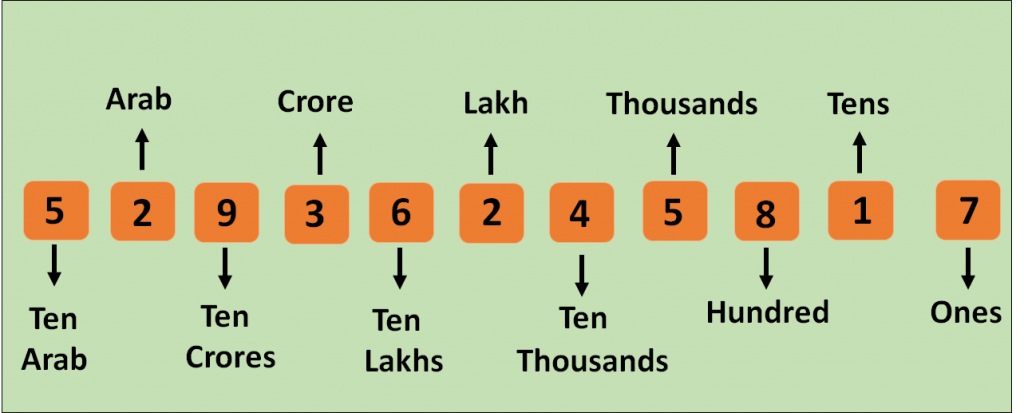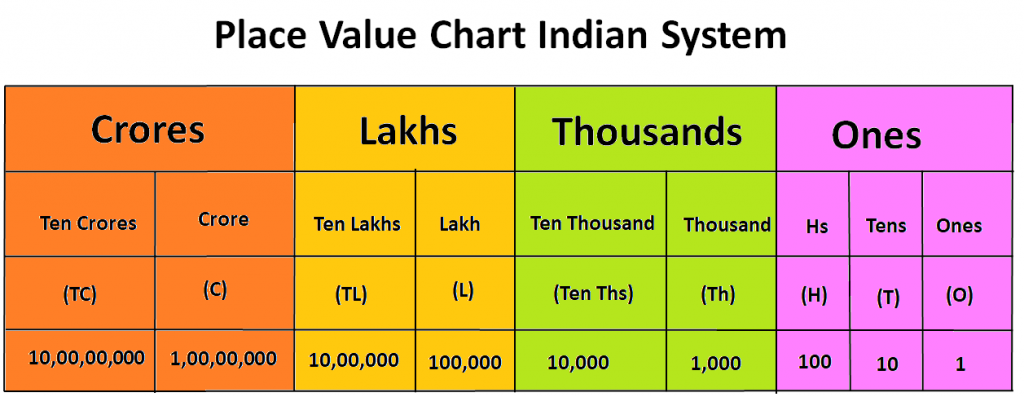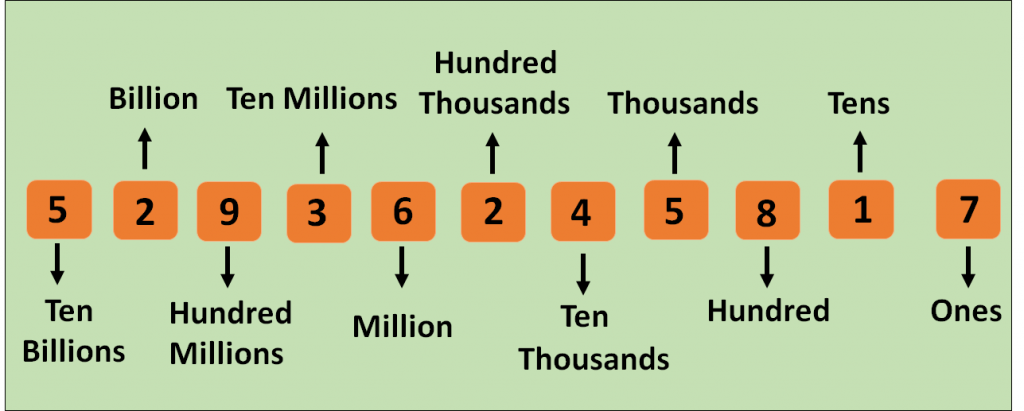International and Indian Place Value System
Place Value-International and Indian System
Indian Place Value System
Place value is defined as the numerical value of each digit in a number depending on its position or place.
Let’s take a number 155. Here we note that the digit 5 is used twice in this number. Both 5 have a different values.
So the place value of right most 5 is ones and the one in the center is tens.
In Indian place value system, The place value chart separated in groups known as periods i.e. ones, thousands, lakhs, crores and Arab and so on.

Above number is read as Fifty two arab, ninety three crore, sixty two lakh, forty five thousand, eight hundred seventeen.
The 1st period consists of (Ones, Tens, Hundred).
The 2nd period consists of (Thousand and 10 Thousand, and 1 Hundred).
The 3rd period consists of (1 Lakh and 10 Lakh).
The 4th period consists of (Crore and 10 Crore).
The 5th period consists of (Arab and 10 Arab).
We read place value chart from left to right. we start grouping the number from right in group of 3 and further group of 2.

In the number 50,34,21,987 the place value of each digit are:
7 – Ones Place
8 – Tens Place
9 – Hundreds Place
1 – Thousands Place
2 – Ten Thousands Place
4 – Lakhs Place
3 – Ten Lakhs Place
0 – Crores Place
5 – Ten Crores Place
A Place value chart shows the value of each digit in a numeral based on its position and recognize large numbers.
| Lakhs | Ten thousands | Thousands | Hundreds | Tens | ones |
| 2 | 3 | 4 | 5 | 6 | 7 |
234,567 Two hundred, thirty four thousand, five hundred sixty seven.
| L | TTh | Th | H | T | O |
| 5 | 5 | 5 | 8 | 7 | 2 |
555,872 Five hundred, fifty five thousand, eight hundred seventy two.
International Place Value System
The place value chart used in many countries of the world is called the International Place Value Chart.

In International place value system, we start grouping the number from right in group of 3, called periods namely Ones, Thousands and Millions(nine places from right to left).
Every periods is made up of three place values. Ones period has three values are ones, tens and hundreds.
The next period is made up of one, ten and hundred thousands.

The 1st period consists of (Ones, Tens, Hundred).
The 2nd period consists of (Thousand, 10 Thousand, and 100 Thousands).
The 3rd period consists of (Million, 10 Million and 100 Million).
The 4th period consists of (Billion, 10 Billion and 100 Billion).
The next three places make millions period and the pattern continues. To read easily the number, we put the comma or space after every three digits from the right.
In the number 50,34,21,987 the place value of each digit are:
7 – Ones Place
8 – Tens Place
9 – Hundreds Place
1 – Thousands Place
2 – Ten Thousands Place
4 – Hundred Thousands Place
3 – Millions Place
0 – Ten Millions Place
5 – Hundreds Millions Place
When we read very large numbers, we arrange the numbers into periods with the help of comma as a separator.
Let’s see some examples,
95823036. Now check the position of each digit.
95,823,036
Ninety five million, eight hundred twenty three thousand, thirty six.
| TM | M | HTh | TTh | Th | H | T | O |
| 9 | 5 | 8 | 2 | 3 | 0 | 3 | 6 |
34,091,258
Thirty four million ninety one thousand two hundred fifty eight.
5,763,241
Five million seven hundred sixty three thousand two hundred and forty one.
65,320,004
Sixty five million three hundred twenty thousand four.
60,902,325
Sixty million nine hundred and two thousand three hundred twenty five.
735,421,386
Seven hundred thirty five million four hundred twenty one thousand three hundred eighty six.
7,253,831
Seven million two hundred fifty three thousand eight hundred thirty one.
30,000,005
Thirty million and five.
Example: In the number 653498, write the digit that is in
(i) One’s place (ii) hundred’s place (iii) hundreds thousand’s place (iv) ten thousand’s place (v) ten’s place.
Solution: (i) One’s place is 8 (ii) hundred’s place is 4 (iii) hundreds thousand’s place is 6 (iv) ten thousand’s place is 5 (v) ten’s place is 9.
Write the numbers in International and Indian place-value system place commas and name of the following numbers.
721336598 in Indian system
Let’s arrange the digits from left to right according to its places as ones, tens, hundreds, thousands, etc., in the indian place value system and read the number.
The number is written as 72,13,36,598 and read as,
Seventy two crores thirteen lakh thirty six thousand five hundred and ninety eight.
721336598 in International system
Now arrange the digits from left to right according to its places as ones, tens, hundreds, thousands, etc., in the international place value system and read and write the number.
The number is written
721,336,598
Let’s arrange the digits from left to right under the places as ones, tens, hundreds, thousands, etc., and read the number.
72,13,36,598
Seventy two crores thirteen lakh thirty six thousand five hundred and ninety eight.
International Number System and Indian Number System Comparison
In both system (International Number System and Indian Number System) 5 digit numbers are read in the same way.
We see a simple comparison table to read the numbers in both system.
| Indian Number System | Figures (Indian) | International System | Figures (International) |
| One | 1 | One | 1 |
| Ten | 10 | Ten | 10 |
| Hundred | 100 | Hundred | 100 |
| Thousand | 1,000 | Thousand | 1,000 |
| Ten thousand | 10,000 | Ten thousand | 10,000 |
| Lakh | 1,00,000 | Hundred thousand | 100,000 |
| Ten lakh | 10,00,000 | One million | 1,000,000 |
| One crore | 1,00,00,000 | Ten millions | 10,000,000 |
| Ten crores | 10,00,000,000 | Hundred millions | 100,000,000 |
| Arab | 1,00,00,00,000 | Billions | 1,000,000,000 |
| Ten Arab | 10,00,00,00,000 | Ten Billions | 10,000,000,000 |
Now we look some more numbers
| Place Value | Numbers | Zeros |
| Ones | 1 | 0 |
| Tens | 10 | 1 |
| Hundred | 100 | 2 |
| Thousand | 1,000 | 3 |
| Ten thousands | 10,000 | 4 |
| Hundred thousands | 100,000 | 5 |
| Million | 1,000,000 | 6 |
| Ten millions | 10,000,000 | 7 |
| Hundred millions | 100,000,000 | 8 |
| Billion | 1,000,000,000 | 9 |
| Ten billions | 10,000,000,000 | 10 |
| Hundred billions | 100,000,000,000 | 11 |
| Trillion | 1,000,000,000,000 | 12 |
| Ten trillions | 10,000,000,000,000 | 13 |
| Hundred trillions | 100,000,000,000,000 | 14 |
| Quadrillion | 1,000,000,000,000,000 | 15 |
| Ten quadrillion | 10,000,000,000,000,000 | 16 |
| Hundred quadrillion | 100,000,000,000,000,000 | 17 |
| Quintillion | 1,000,000,000,000,000,000 | 18 |
Difference between International Number System and Indian Number System
| International place Value System | Indian Place Value System |
| Groups of three periods (Ones, thousands and millions) are divided into nine places. | Groups of four periods (Ones, thousands, lakhs and crores) are divided into nine places. |
| In international place value system Millions are written after thousands. | In Indian place value system Lakhs are written after thousands. |
| Place values are ones, tens, hundreds, thousands, ten thousands, hundred thousands, millions, ten millions and hundred millions. | Place values are ones, tens, hundreds, thousands, ten thousands, lakhs, ten lakhs crores and ten crores. |
| Millions and billions n Indian place value system are used In international place value system. | Lakhs and crores units are used in indian place value system. |
| International place value system is based on 10³ (ten to the power three) | Indian place value system is based on 10³ (ten to the power three) and then is followed by two digits split after the hundredths place. |
| International place value system is used in many countries of the world. | Indian place value system is followed in India, Bangladesh and Pakistan. |
The place value chart of the International System
100 thousand = 100,000
1 million = 1,000,000
10 millions = 10,000,000
100 millions = 100,000,000
The place value chart of the Indian System
1 hundred = 10 tens
1 thousand = 10 hundreds = 100 tens
1 lakh = 100 thousands = 1000 hundreds
1 crore = 100 lakhs = 10,000 thousands
Relation Between Indian and International Number System
100 Thousand = 1 Lakh
1 Million = 10 Lakhs
10 Millions = 1 Crore
100 Millions = 10 Crores
1 Million = 1000 Thousands
1 Billion = 1000 Million
Practice Questions
Find the Place Value
i) 5 in 546
(ii) 3 in 5436
(iii) 6 in 2546
(iv) 2 in 153254
(v) 7 in 985467
Answer:
i) Place value of 5 in 546 is hundred.
(ii) Place value of 3 in 3 in 5436 is tens.
(iii) Place value of 6 in 6 in 2546 is thousand.
(iv) Place value of 2 in 2 in 123954 is ten thousands.
(v) Place value of 7 in 7 in 985467 is ones.